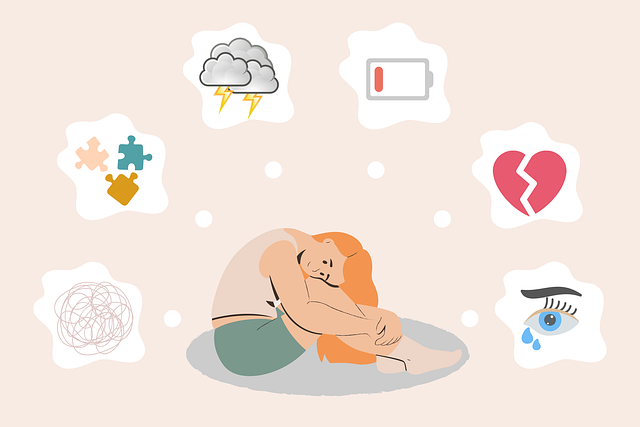Burnout among healthcare providers, fueled by factors like long hours, heavy workloads, and lack of support, poses significant risks to individual well-being, patient care, and system performance. Early identification of conduct disorder in children is crucial, with strategies like regular check-ins, positive reinforcement, and CBT through organizations offering stress management workshops. Creating a supportive work environment that promotes self-care, open communication, and mental health practices is key to preventing burnout. Prioritizing self-care, including engaging in mental health activities and seeking therapy for conduct disorder, enhances well-being and patient care.
In today’s demanding healthcare landscape, preventing burnout among providers is paramount. This article explores effective strategies to combat fatigue, offering a comprehensive guide for optimal well-being. We delve into understanding burnout’s root causes and its profound impact on caregivers, particularly in the context of treating children with conduct disorder. Key topics include early detection techniques, CBT as a management tool, cultivating supportive work environments, and empowering self-care practices tailored to healthcare workers’ unique challenges, emphasizing the importance of holistic approaches, including therapy for children with conduct disorder.
- Understanding Burnout in Healthcare Providers: Causes and Impact
- Identifying Children with Conduct Disorder: Early Detection Strategies
- Cognitive Behavioral Therapy (CBT) for Conduct Disorder Management
- Creating a Supportive Work Environment to Prevent Burnout
- Self-Care Practices for Mental Well-being of Healthcare Workers
Understanding Burnout in Healthcare Providers: Causes and Impact

Burnout among healthcare providers is a growing concern, impacting not only individual well-being but also patient care and overall system performance. It manifests as a state of emotional exhaustion, depersonalization, and reduced personal accomplishment, often fueled by prolonged exposure to high-stress environments, heavy workloads, and lack of support. In the medical field, where professionals constantly face life-or-death situations and diverse patient needs, burnout rates are alarmingly high.
Several factors contribute to this phenomenon. Long working hours, especially in emergency departments or intensive care units, can lead to chronic fatigue. The constant demand for increased productivity and documentation adds to the stress. Moreover, interpersonal challenges within healthcare settings, such as poor communication or lack of respect for professionals’ expertise, can further exacerbate burnout. For instance, healthcare providers treating children with conduct disorder often face complex situations requiring not only clinical proficiency but also cultural sensitivity, which demands continuous learning and adaptation. This calls for comprehensive solutions, including enhancing healthcare provider cultural competency training, public awareness campaigns development, and promoting self-care routine development for better mental health.
Identifying Children with Conduct Disorder: Early Detection Strategies

Identifying Conduct Disorder in children early is a crucial step in preventing burnout and promoting their mental wellness. This often requires a multifaceted approach where teachers, parents, and healthcare providers play an active role. Observing behavioral patterns such as aggression, defiance, or persistent rule-breaking can be indicators of the disorder. Early detection strategies include regular check-ins with children to assess their emotional well-being and providing them with opportunities for social interaction and positive reinforcement.
Therapy for Children Conduct Disorder is more effective when intervention occurs at a young age. Organizations focused on burnout prevention in healthcare professionals often incorporate stress management workshops tailored for parents and educators, equipping them with tools to identify red flags early. By fostering open communication and implementing these strategies, communities can create a supportive environment that nurtures mental wellness and prevents conduct disorder from escalating, thereby reducing the risk of future burnout for both children and those who support them.
Cognitive Behavioral Therapy (CBT) for Conduct Disorder Management

Cognitive Behavioral Therapy (CBT) has emerged as a highly effective approach to managing Conduct Disorder in children. This evidence-based therapy focuses on identifying and modifying negative thought patterns, behaviors, and emotional responses that contribute to disruptive conduct. By teaching children coping strategies, CBT empowers them to make more positive choices and navigate social interactions with greater ease.
Through structured sessions, therapists help young individuals understand the connection between their thoughts, feelings, and actions, fostering self-awareness and self-regulation. This proactive approach not only addresses immediate behavior issues but also equips children with lifelong skills crucial for burnout prevention. In light of the increasing public awareness campaigns development around mental health, integrating CBT into conduct disorder management aligns seamlessly with risk management planning for mental health professionals.
Creating a Supportive Work Environment to Prevent Burnout

Creating a supportive work environment is an essential strategy to prevent burnout among healthcare providers. This includes fostering a culture that prioritizes well-being and encourages open communication. By implementing social skills training and promoting self-care routine development for better mental health, healthcare facilities can help staff manage stress and maintain a positive mindset. Effective communication strategies should be encouraged at all levels, ensuring that providers feel heard, valued, and supported by their colleagues and superiors.
A supportive work environment also involves providing access to therapy for children with conduct disorder or other mental health challenges. This not only benefits the children but also aids in stress reduction among healthcare providers who may encounter these cases regularly. By integrating these various strategies, healthcare organizations can create a nurturing atmosphere that enhances job satisfaction and reduces the risk of burnout.
Self-Care Practices for Mental Well-being of Healthcare Workers

Healthcare workers often put their patients’ well-being before their own, but it’s crucial to emphasize that self-care practices are essential for maintaining mental resilience and preventing burnout. Incorporating regular activities that promote mental health can help build inner strength and enhance overall well-being. This may include engaging in hobbies outside of work, practicing mindfulness or meditation, and seeking therapy for any underlying conditions, such as conduct disorder in children. These self-care strategies not only benefit the individual but also positively impact their ability to provide quality patient care.
In addition to personal wellness activities, healthcare professionals should prioritize open communication and seek support from colleagues and supervisors. Recognizing signs of burnout early on is vital for implementing effective risk assessments for mental health professionals. Through fostering a culture that encourages self-care and resilience building, healthcare organizations can help their staff maintain a healthy work-life balance, thereby reducing the risk of professional exhaustion.
In addressing healthcare provider burnout prevention, strategies such as early detection of conduct disorder in children through cognitive behavioral therapy (CBT) and creating supportive work environments are crucial. By implementing self-care practices alongside these initiatives, the mental well-being of healthcare workers can significantly improve. Remember that a holistic approach, encompassing both professional development and personal care, is key to mitigating burnout and fostering sustainable careers in healthcare.














